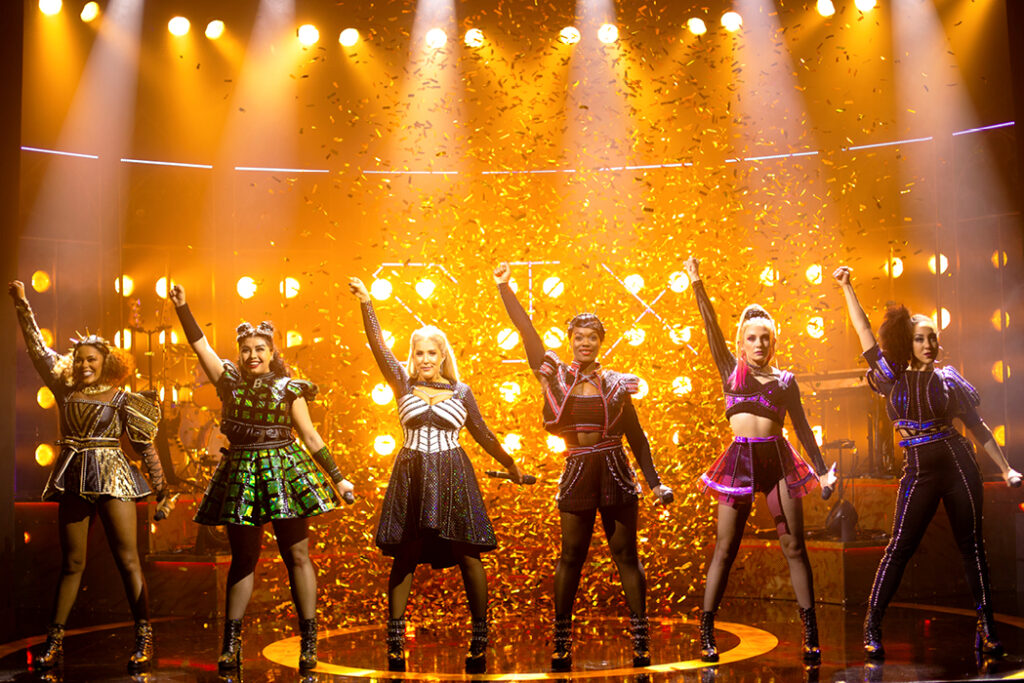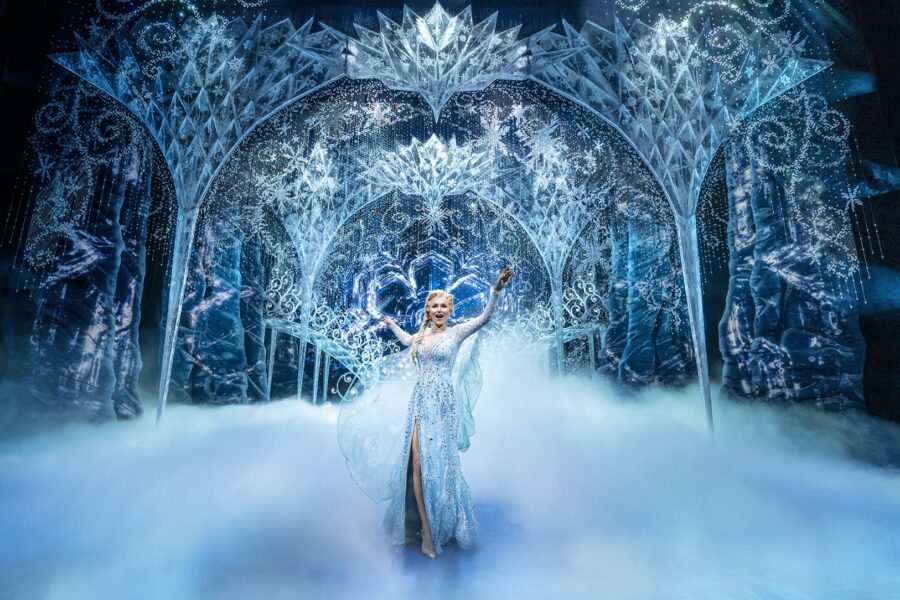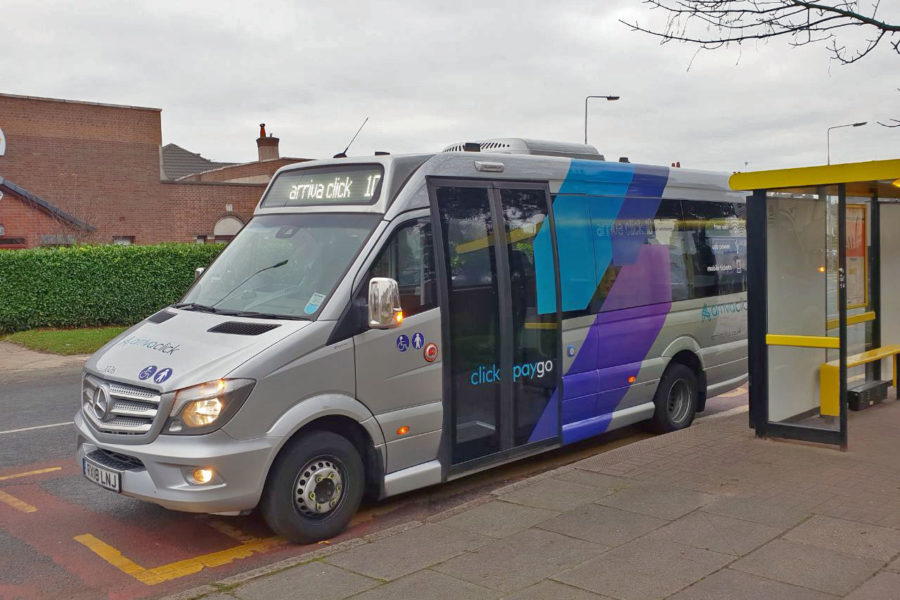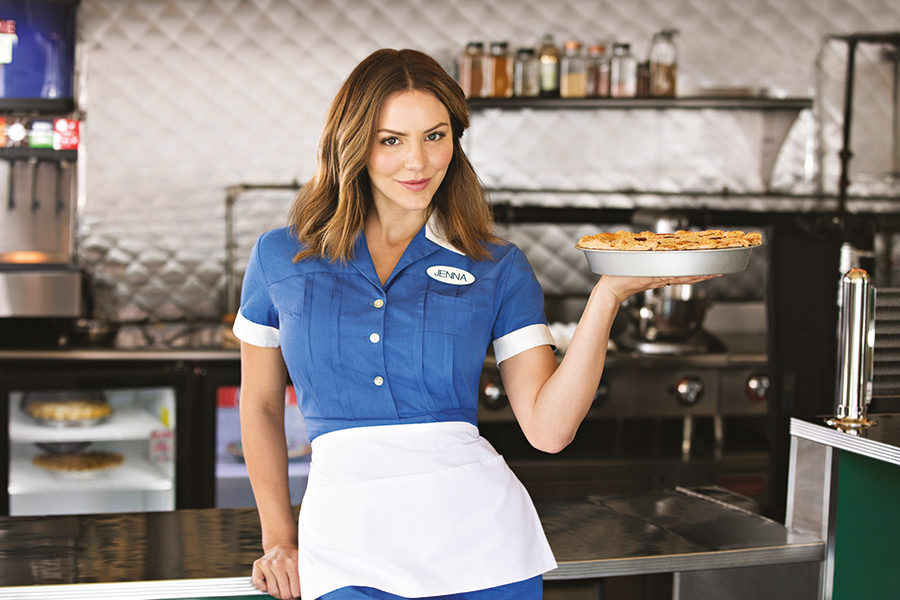Divorced, Behead, LIVE! The original Historemix, Six continues to wow West End audiences, now reigning over London’s Lyric Theatre for a strictly limited season.

REVIEW: ‘Six’
Lyric Theatre - 13/06/2021 - ⭐️⭐️⭐️⭐️⭐️⭐️
I’ll tell you what: it’s bloody great to be back in a theatre. It’s a moment so many of us have been looking forward to for so long, and—for me—it meant I had to make it count. My first show since January 2020 (itself an experience—like most of 2020—best forgotten), it had to be a special one—so what better show to choose than Toby Marlow and Lucy Moss’ feminist extravaganza Six.
Recounting the tales of Henry VIII’s six wives from their perspective, Six opened in the West End back in 2017 at the Arts Theatre to rave reviews, and has since been performed all over the world—on land and at sea! Taking the premise of a pop concert staged by the Wives, the show draws strongly on contemporary pop culture, including iconic feminist musicians and themes around social media and the digital age to modernise the story for new audiences. The single-act, 80-minute show is one of the first to re-open in London’s West End following the Covid-19 pandemic, and is temporarily reigning over the Lyric Theatre on the world-famous Shaftesbury Avenue in the heart of Theatreland. As ever: there’s spoilers beyond the fold—don’t lose your head!
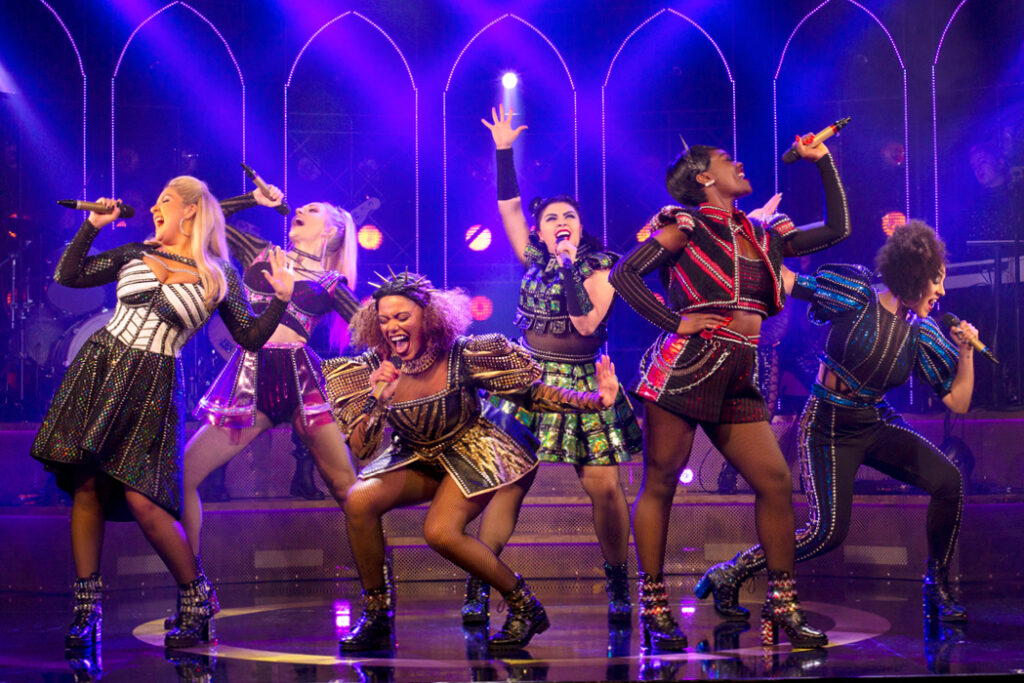
Yes, I know, I’m a bit late to the Six party… except I’m also not! My first encounter with this show was way back in 2018 at the ever-enjoyable West End Live, and was also one of Six’s first performances ahead of its rise to prominence. I recall the cast explaining on stage that they’d only met earlier that week to workshop and rehearse the number… not that we could tell: see for yourself! I’ve tried a few times since then to see the show at the Arts Theatre but, for whatever reason, circumstances have always conspired against it.
A unexpectedly-free Sunday afternoon provided the opportunity to change all that, with an alignment of the stars landing me a socially-distanced bubble for one in the front row of the Dress Circle at the Lyric Theatre, for Six’s Sunday matinee. My first visit to a theatre since the pandemic began, I was curious but cautious about the experience, not quite knowing what to expect. Whilst I’m fully vaccinated, the social distancing rules—including the wearing of masks in indoor venues—remain in force, immediately meaning that there was going to be a different vibe to other shows I’ve seen before.
But I shouldn’t have worried! Arrival at the Lyric was seamless, with the usual bag checks accompanied by a temperature check and the track and trace protocol that’s come to be expected over the last year. Entry was by a lettered door to keep people as far apart as possible, with a very clear entry system then signposted to get everyone to their seats. Within the auditorium, out of use seats were clearly signalled with discrete signage, and on the Dress Circle this meant every other row was out of use too. It was a very relaxed atmosphere, with a suitably ‘traditional’ on-stage preset backed by gentle harpsichord riffs to set the scene. It’s not quite theatre as we know it… but it’s not far off. With—you guessed it—six(!) minutes to go before curtain up, the customary warning was announced, and it’s fair to say I was already getting just a tad emotional.
The ‘Historemix’ begins with the six Queens entering stage centre: right where they should be. Purple lighting soon gives way to pink and gold flashes, as the first notes of Ex-Wives strike up. It’s a song that’s become quickly cemented as a West End favourite, and should need no introduction to showtune fans. We’re introduced to each of our protagonists, Catherine of Aragon (divorced), Anne Boleyn (beheaded), Jane Seymour (died), Anne of Cleves (divorced), Katharine Howard (beheaded) and Catherine Parr (survived) and the premise of the show: a pop concert with a difference, pitting each of our unlucky ladies against each other to find out just which of Henry VIII’s wives had the unluckiest of lives.
It’s a slick number; modernity is teamed with period, the staging incorporating LED bars in a Tudor style and the costumes taking on a style that wouldn’t be out of place in a rock opera. Each Queen is given their own unique colour scheme with a nod to their history, although this wasn’t as clear as always during my performance due to an unusually high number of alternates on stage: half of the regulars were replaced. Not that it matters, of course: Six has a reputation for attracting some of the best in the business, and I can honestly say that I was mesmerised by every single Queen in turn.
One of the things I’ve always wondered about the costumes is where the Queens stash their microphones when they’re not using them—the question being immediately answered by handy pouches on the right of each costume. It might seem trivial, but my compering gigs have taught me that they’re remarkably heavy things to be holding for 80 minutes straight! Honourable mention on the costume front also needs to be made of the matching sparkly boots… if anybody reading would like to sliiiiiiide a pair into my mentions, I’m a size 9…

The on-stage four-piece band are also introduced early on, referred to, ingeniously, as the ‘Ladies in Waiting’, and each also giving an on-stage name and persona (I’m so sorry, I couldn’t catch them—but the talented gals on the music were Amy Shaw on guitar, Rachel Espuete on bass and Alice Angliss on the drums, all led by musical director Arelene McNaught also pressing away on the keys). They’re as much a part of the action as the Queens themselves, and really add to the immersion of being at a girl power gig.
The production is, as you’d expect, littered with historic references to the era, including jokes about Protestantism, Thomas Cromwell and the fates of the Queens themselves. They’re front and centre and not afraid to shout about it: it’s girl-power and feminism ramped all the way up to six with the likes of Henry VIII being relegated to mere side stories. There’s also plenty of innuendo: Six is remarkably raunchy, whilst keeping on the right side of being considered family friendly!
Up to perform first is Zara MacIntosh as Catherine of Aragon performing No Way, a track about Catherine’s troubled relationship with Henry, eventually leading to their marriage annulment and the breakaway of England from Catholicism. Clever use of the LED bars at the back of the stage reference the religious elements, notably with the depiction of two white crosses when referencing Catherine being sent to a nunnery. The remaining five Queens remain on stage throughout the number—and indeed all numbers—providing backing vocals and responses to the song as required. MacIntosh’s stage presence was strong throughout, the confidence of the character coming through with slick choreography matching the vocal prowess. MacIntosh is the first of the alternates on the roster this afternoon (she also covers Katherine Howard) and there’s certainly no giveaway.
The Queens reconvene after the number with increasing animosity between them; they’re all keen to put across their version of ‘Herstory’, and up next is the anthemic Don’t Lose Your Head, sung by Courtney Bowman in the role of Anne Boleyn. It’s a frivolous and fun number, with Bowman really bringing out the sweet and innocent yet determined nature of Boleyn. It’s the first song to really draw on modern social media culture and an almost complete naivety about the consequences of actions, with the character heavily influenced in the modern spectrum by the likes of Avril Lavigne and Miley Cyrus, the latter providing the iconic space buns worn by Bowman. The green accents in the costume also play on the purported connection of Anne Boleyn and the historical ballad Greensleeves, said to have been written for her by Henry VIII, albeit disputed by experts on the era.
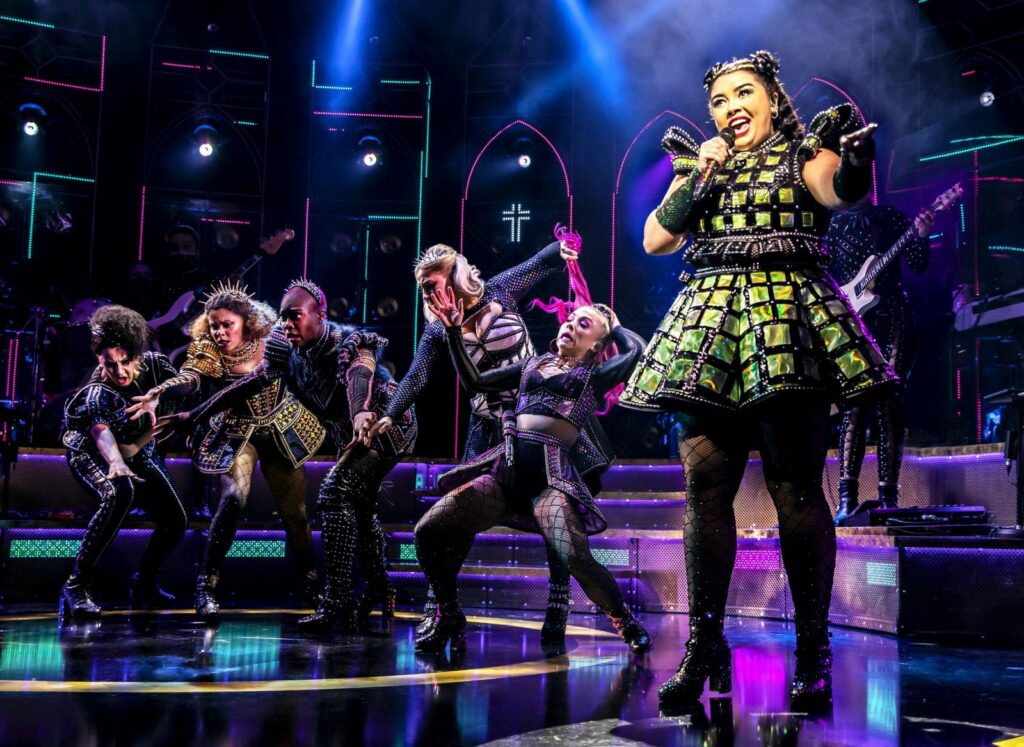
The friendly rivalry between the Queens really starts to come to the forefront, with strong choreography pairing together Catherine of Aragon and Anne Boleyn, symbolising the overlapping nature of their relationships with Henry. Indeed, Bowman’s overall characterisation of Boleyn makes her a really powerful and emotive character, behind the happy-go-lucky façade that might at first seem to be the character’s pinnacle. Some of the smuttier references also really start to come through, with Marlow and Moss’ clever writing and research really paying off: connecting together, for instance, losing her head and being good at certain acts in bed (no, I’m not going to spell it out!). One of my favourite phrases certainly comes to mind to sum up Boleyn, even if it’s not perhaps the primary intention: conniving harlot. “Queen, please”, retorted at the end of the song, also raised a smile on my face and is another strength of putting a contemporary spin on the tale. A tight spotlight on Bowman’s head at the end of the song really hammers home the ‘beheaded’ title.
At this stage I really regretted having broken my one cardinal rule for musical theatre: never listen to the full soundtrack before seeing a show in the flesh. It’s a rule I’d long-broken for Six, and I really wish I hadn’t. Previews put out as part of media circuits or other events, such as West End Live, are fine, but original soundtracks are out. I find that listening to them before you’ve seen the show builds up a particular image and makes you complacent with the studio setting of the songs, which is often very different from how the stage production—and therefore the intentions of the creative team—is put together. Natalie Paris in the role of Jane Seymour epitomises this.

Her slow ballad, Heart of Stone, changes the pace of the show, with the remainder of the Queens sitting around her rather than having highly choreographed routines. It feels almost like a soliloquy for Seymour, professing her love for Henry as well as her love for her child, whom she died giving birth to. The light blue wash with singular spot place all the focus on Paris: and that’s really where you want the focus to be. A much more emotional and tightly cut rendition is provided, against the cast recording, with her determined viewpoint being entirely reinforced by the soft, delicate—yet still incredibly powerful—delivery captivating the audience. At this stage my notes simply say “THE BEELLLLTTTTT”; I think that probably sums up the crescendo of the song perfectly. The solidarity between the Queens becomes all the more clear, the combination of their backing vocals and Paris’ lead giving me goosebumps. Again, the inter-song banter between the Queens really helps the audience understand and relate with the characters, whilst also making the side point that, quite often, the squabbling and disagreements are often caused by the patriarchy.
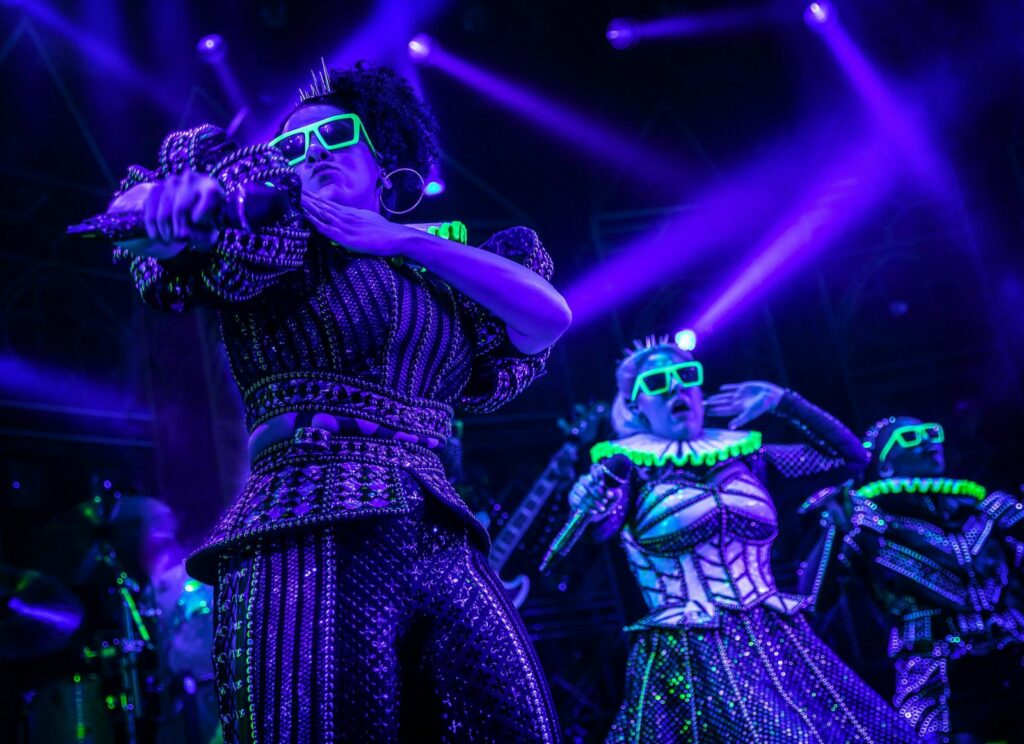
The halfway point of the show signals another group number, Haus of Holbein, an upbeat clubby vibe setting the scene for Anne of Cleves’ solo. The contemporary references continue with the audience told to “adjust [their] location settings”—a reference to online dating apps—as the blacked-out stage fills with smoke. Bright white lights pierce through the fog, with the band and cast now sporting fluorescent yellow sunglasses and ruffled collars underneath ultraviolet lighting to really hammer home the 90s rave vibes.
Anne of Cleves, in the capable hands of ‘super swing’ Collette Guitart, was perhaps my unexpected highlight of the entire show. Guitart, who is able to play all six of the roles as required, again lacks the tailored costuming of the permanent Queens, but it wasn’t needed: less get up and more Get Down to the latest tale. An alternative title might be ‘Swipe Right’… yes, it’s another song all about online dating, and one that fits the history rather perfectly. Again, the LED batons at the back of the stage are used to good effect—red squares denoting a rejection and a green square for when Anne settles on Henry VIII. The lyrics “I didn’t look like my profile picture” are brilliantly contextualised with the comparison to online dating apps, and the suggestion that Anne of Cleves was, in fact, a catfish. Perhaps there’s no surprise that relationship ended in divorce.
It was clear that Guitart and the rest of the cast were clearly having the time of their lives, and Get Down is perhaps the perfect song to epitomise this. The staging centres around the idea of a girls’ night out, with red and white lighting adding to the somewhat ‘lairy’ scenes! The LED batons are again used to create the outline of Cleves’ “palace in Richmond”; all in all the staging completely changed my views on Get Down, which was another song I didn’t have particularly huge amounts of love for prior to seeing the show—proving, once again, why I really need to stick to my policy of not listening to the soundtrack before I’ve seen the show!
Up next is perhaps the Queen I was looking forward to the most: Katherine Howard. Truly “a ten amongst these threes”, I have a strong affinity with Howard and her promiscuous ways. Played by the incredible Sophie Isaacs, Howard is characterised by her pink hair and choker, the latter symbolising her ultimate beheading. Whilst the other Queens may refer to her as “the least relevant Katherine”, this is a view I simply cannot share. Howard’s story is filled with innuendo and references to her shady past, yet it’s also a fun and dynamic number fully allowing the sass of the Queen to be brought to the surface. Isaac’s rendition of All You Wanna Do was incredibly powerful and emotional, with well-timed, crisp delivery of the lyrics teamed with a creative dance routine creating a memorable experience.
I’ll admit, I was a little sceptical of Isaac’s casting going into the performance, based on having seen her in other productions. Whilst this was my first time of seeing Six, I’d created an ‘idea’ in my head of how Kate Howard could be played, and wasn’t sure if Issacs was the best fit. These fears quickly proved unfounded, however, and I was feeling much more emotion for Kate than I’d previously taken from the song. The staging also brought the performance to life, with Kate’s signature pink augmented with blue light (trans pride anyone? 👀 I keep telling you all, Katherine Howard is the role I was born to play.), later giving way to a solitary purple spot on Howard for the culmination of the song. Six stars all round.
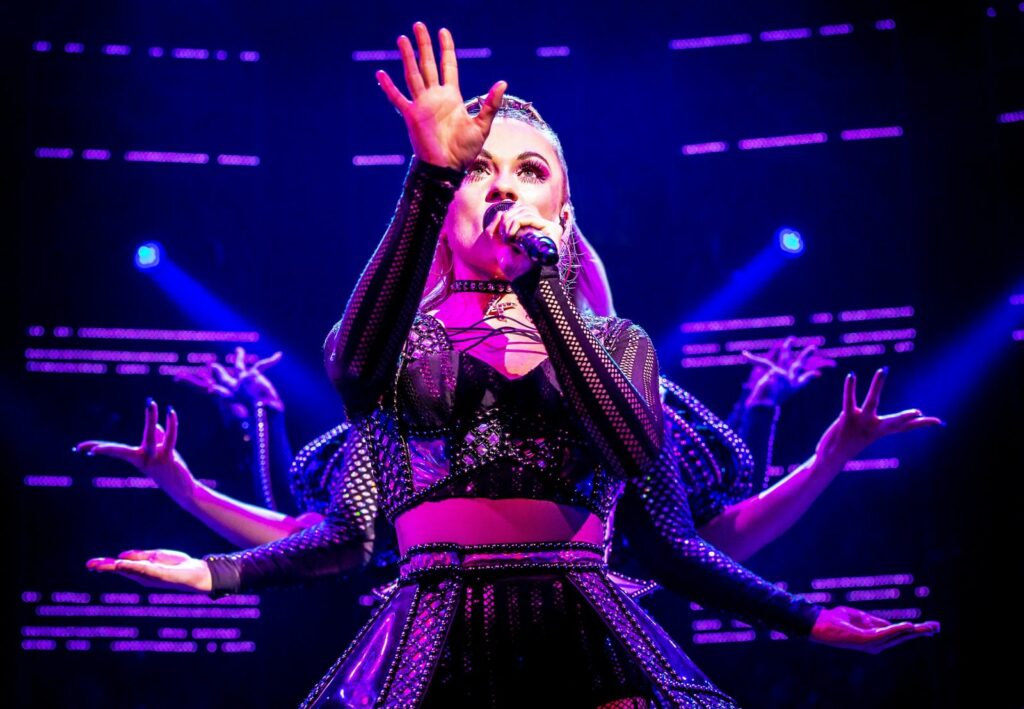
The banter amongst the Queens continues after Howard’s song—after all, we’re now five songs into a six song song competition—with a notable mention of Catherine of Aragon’s “four choruses!” standing out. Each of the Queen’s continues to justify why their song was the greatest, until “I’m a survivor” Catherine Parr (Hana Stewart, our final alternate) interrupts, pointing out that she is still yet to perform. Unexpectedly, the band strike up a funky disco beat, before it falls to silence and peters out, with Parr refusing to sing. In a plot twist, she asks for the working lights to be brought up and enters into an important monologue: why are the Queens competing against each other and following the generally-believed history, when in fact they should be working together to tell their own, unique herstory. Parr questions why they are focussing on the trauma and abuse they experienced as wives of Henry VIII—rebuked by one queen with “someone’s got a conscience”—and instead uses her moment in the spotlight to perform a slower ballad—a love letter to her previous lover and future (fourth) husband, Thomas, in song form.
Stewart’s costuming is again subdued compared to the primary Queens (big big fan of the side pony though, we really should bring those back as every fashion), but it’s a very clever and ingenious way of keeping within the overall look and feel of the show whilst also providing the freedom for alternates to cover multiple roles… sometimes on the same night! Indeed, the night before my viewing of Six, Stewart actually changed roles from Jane Seymour to Catherine Parr mid-show; an incredible feat and stand-out talent for swings, alternates and understudies across the West End and beyond. Never be angry if the cast isn’t the ‘main’ players—you’ll get just as special a show, if not more so, with whoever ends up in the role.
I Don’t Need Your Love is an emotive number highlighting that it wasn’t all fun and roses with Henry VIII, and a notable pace change from those which came before. It relates to Parr’s marriage to Henry over her flame Thomas Seymour (yes, brother to Jane… most of the Queens are in fact related or knew each other in some way!) out of essentially fear, but she did then marry Seymour after his death (bit of a history lesson for you there). The song highlights all of Parr’s other achievements in life and is a refusal to accept the narrative of being Henry’s final wife as the sole reason for remembering her. It’s a true feminist anthem, and is the perfect way to round off this festival of girl power. But is it enough to win this competition…?
Reunited once more, the Queens are stronger than ever, acknowledging when they work together they are an unstoppable team. So, why have a competition against each other when they could be working together…? Or perhaps, this resolution is just a little bit too coincidental… just “like it was planned”. Yes, the framing of the concert as a competition is a friendly ruse amongst our players, showing their strengths and allowing us, the audience, to see that actually they are the important ones in herstory, and not Henry. Our LED Tudor latticework returns (I really am a fan of those LED batons) and we enter the end game: Six.
Now one of the best known bops in Theatreland, Six is a mashup of themes and riffs from each of the Queens, recapping their story and celebrating everything that they have achieved. The number is loud, bold and fun—SIX appears on the LED batons (last mention I promise)—with the song’s five-minute countdown actually becoming “four”, “three”, “two” and “one” more minute(s) in the live production. I really enjoyed the staging and pacing of the number, including a much more subdued version of the bridge all ready to build into the big finish. Each of the Queens takes on a suitable power pose, before building into the iconic “one of a kind…” routine for one of the most enjoyable finales I think I’ve ever witnessed in a theatre. The anthemic nature of Six really suits the live band too, with the drum solos in particular really standing out for me. Confetti cannons round everything off in the best possible way.
But it’s not quite the end of the show, or the Historemix, just yet…
There’s one final surprise in store for the audience. I’d been tipped off that ‘something’ happens, but I’d managed to dodge exactly what. If you want to keep the surprise, stop reading here!
In an unusual yet welcome move, at this stage the cast encouraged the audience to take out their mobile phones and cameras to record a special, final number. One of my biggest bugbears of Theatreland over the last few years has been the wider and wider prevalence of mobile phones during curtain calls—or indeed during the performances themselves. Even as an audience member they’re incredibly distracting, and really detract from the atmosphere for all. This wasn’t true here, however: the show is over, and this is a deliberate opportunity for fans of the Queendom to get a lasting image without negatively detracting from anybody else’s performance.
The appropriately-dubbed Megasix is Six souped up to the max: it’s a remixed version with each Queen reprising their chorus: it’s the encore to crown all encores. And, one of the best parts about it is that it’s nearly always different given the often changing nature of who’s playing the roles—absolutely a reason to go back again and again. You can check out my Megasix at the end of this post.
Undoubtedly, the Queens have taken “their crowning glory”; I regret sleeping on Six for so long but I doubt it’ll be long before I’m back! Quite frankly it really is one of the best things I’ve ever seen on stage, and was the perfect choice to welcome back the West End after such a long time away. I’d absolutely recommend it to anyone both in London and once it’s out on tour again; you really won’t be disappointed.
Long may Six reign over us all.
Six is currently playing at the Lyric Theatre until 29th August 2021, after which it will transfer to the Vaudeville Theatre. Tickets are on sale now. The show runs for 80 minutes with no interval.
